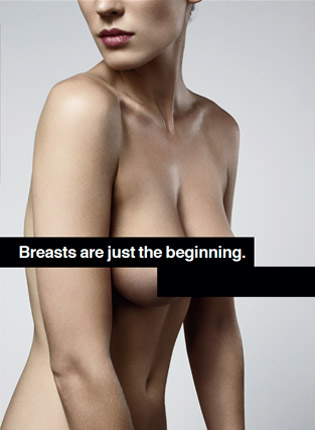
Who needs implants? How tissue engineering and a new kind of stem cell can help the body rebuild itself. Photo: David Slijper
To be in the company of Chris Calhoun is to encounter breasts, and encounter the damn things anytime, anywhere—including over a plate of spaghetti in a bustling Manhattan restaurant.
On this spring afternoon, the 44-year-old CEO of San Diego-based biotech company Cytori Therapeutics pulls out his laptop, launches a PowerPoint presentation, and there they are: conical and cantaloupy, As through Ds, beige and pink and taupe and tan, more breasts than you might see in a women’s locker room, never mind in the middle of a lunch table.
A passing waiter does a double take at this lively slide show, but Calhoun is oblivious. He’s talking excitedly about how these women’s bodies led him and his team of scientists to a discovery in tissue engineering, a process that could well be one of the most momentous medical advances of the 21st century: the use of stem cells—specifically stem-cell-enriched adipose (fat) tissue—to enhance, heal, and rebuild injured or damaged organs.
A few taps on his laptop reveal the unsettling “before” images of these seemingly normal breasts. There: a breast with a divot the size of a plum taken out of the bottom from a lumpectomy. There: a chest as flat as a floor mat from a double mastectomy. There: one so misshapen after a partial mastectomy, it’s possible to determine what it actually is only because of its healthy companion. “We realized that for these women there was a huge unmet need for a disruptive change in technology,” Calhoun says of the work that has consumed his team of researchers and surgeons for the past eight years. “It’s the first practical cell therapy.” He pauses. “And it’s breasts.” Which means cancer victims with breasts mutilated by surgery—as well as women who are simply unhappy with their natural assets—can now grow a new and improved pair, with raw materials harvested from their own body fat.
But breast augmentation is just one development (so to speak) in the company’s more ambitious plan: to introduce stem cell medicine to the mass market—and not using the ethically fraught kind of stem cells from human embryos. Instead, based on almost a decade of trials that Cytori and its academic partners have performed on cell cultures, lab rodents, and now humans, they believe their engineered flab cells can treat more organs than you find in a French butcher shop. Chronic heart disease? Check: In human studies released in May, the cells improved patients’ aerobic capacity and shrank the size of the infarct (tissue killed by lack of blood). Heart attack? Check: A human clinical trial, also reported in May, found that the cells increased both the blood supply to damaged heart muscle and the volume of blood that the heart pumped. Kidney injury as a result of cancer therapy? Check: In recent rat studies, the cells improved kidney function. Incontinence after prostatectomy? Check: Another recent study reported that, by 12 weeks after injection, the cells had decreased the amount of urine male volunteers were leaking by 89 percent. If Calhoun and his scientists succeed, they won’t just create more cleavage. They’ll make practical a whole new field, one that medical visionaries have dreamed of for decades: regenerative medicine.
It makes sense to apply Cytori’s technology to enhance breasts instead of, say, repair urinary sphincters as a strategic way to move the patented technology out of rats and into people as soon as possible. Hearts, kidneys, and even sphincters have to work in order for us to survive. But we can live just fine without breast tissue, and, outside of feeding offspring, breasts don’t have to do much. The fact is, the scientific and regulatory hurdles to getting Cytori’s cells into clinical use will be easier to clear for breasts than for other tissue: Breasts simply aren’t as necessary as other organs, so the bar for proving to regulators that the technology works will be lower.
By Sharon Begley | Wired November 2010
